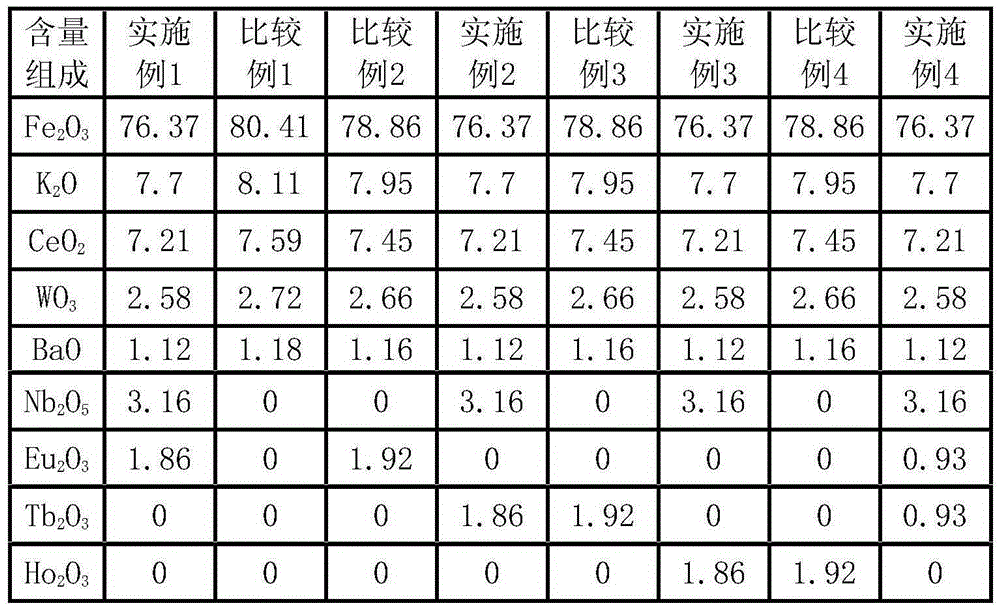Low steam-to-oil ratio ethylbenzene dehydrogenation catalyst
A technology of ethylbenzene dehydrogenation and catalyst, applied in physical/chemical process catalysts, metal/metal oxide/metal hydroxide catalysts, hydrocarbons, etc., can solve the problems of poor stability and low activity of low-potassium catalysts, Achieve the effect of improving electron transfer ability, high activity, and enhancing self-regeneration ability
- Summary
- Abstract
- Description
- Claims
- Application Information
AI Technical Summary
Problems solved by technology
Method used
Image
Examples
Embodiment 1
[0039] would be equivalent to 58.22 parts Fe 2 o 3 iron oxide red, equivalent to 18.15 parts of Fe 2 o 3 Iron oxide yellow, equivalent to 7.7 parts K 2 Potassium carbonate of O, equivalent to 7.21 parts of CeO 2 of cerium oxalate, equivalent to 2.58 parts of WO 3 ammonium tungstate, barium hydroxide equivalent to 1.12 parts of BaO, 3.16 parts of Nb 2 o 5 , 1.86 Eu 2 o 3and 5.69 parts of sodium carboxymethyl cellulose were stirred in a kneader for 1.5 hours, added deionized water accounting for 24.5% of the catalyst raw material gross weight, stirred for 0.5 hours, took out the extruded strips, extruded into particles with a diameter of 3 mm and a length of 6 mm, Put it into an oven, bake at 60°C for 2 hours, and bake at 130°C for 3 hours, then place it in a muffle furnace, and bake it at 550°C for 3 hours, then at 960°C for 3 hours to obtain the finished catalyst. The composition of the catalyst is listed in Table 1.
[0040] 100 milliliters of catalysts are loaded in...
Embodiment 2
[0048] In addition to using Tb 2 o 3 Replace Eu 2 o 3 Except, catalyst preparation method and catalyst evaluation conditions are all identical with embodiment 1, specifically:
[0049] would be equivalent to 58.22 parts Fe 2 o 3 iron oxide red, equivalent to 18.15 parts of Fe 2 o 3 Iron oxide yellow, equivalent to 7.7 parts K 2 Potassium carbonate of O, equivalent to 7.21 parts of CeO 2 of cerium oxalate, equivalent to 2.58 parts of WO 3 ammonium tungstate, barium hydroxide equivalent to 1.12 parts of BaO, 3.16 parts of Nb 2 o 5 , 1.86 Tb 2 o 3 and 5.69 parts of sodium carboxymethyl cellulose were stirred in a kneader for 1.5 hours, added deionized water accounting for 24.5% of the catalyst raw material gross weight, stirred for 0.5 hours, took out the extruded strips, extruded into particles with a diameter of 3 mm and a length of 6 mm, Put it into an oven, bake at 60°C for 2 hours, and bake at 130°C for 3 hours, then place it in a muffle furnace, and bake it at ...
Embodiment 3
[0054] In addition to using Ho 2 o 3 Replace Eu 2 o 3 Except, catalyst preparation method and catalyst evaluation conditions are all identical with embodiment 1, specifically:
[0055] would be equivalent to 58.22 parts Fe 2 o 3 iron oxide red, equivalent to 18.15 parts of Fe 2 o 3 Iron oxide yellow, equivalent to 7.7 parts K 2 Potassium carbonate of O, equivalent to 7.21 parts of CeO 2 of cerium oxalate, equivalent to 2.58 parts of WO 3 ammonium tungstate, barium hydroxide equivalent to 1.12 parts of BaO, 3.16 parts of Nb 2 o 5 , 1.86 copies of Ho 2 o 3 and 5.69 parts of sodium carboxymethyl cellulose were stirred in a kneader for 1.5 hours, added deionized water accounting for 24.5% of the catalyst raw material gross weight, stirred for 0.5 hours, took out the extruded strips, extruded into particles with a diameter of 3 mm and a length of 6 mm, Put it into an oven, bake at 60°C for 2 hours, and bake at 130°C for 3 hours, then place it in a muffle furnace, and b...
PUM
 Login to View More
Login to View More Abstract
Description
Claims
Application Information
 Login to View More
Login to View More - R&D
- Intellectual Property
- Life Sciences
- Materials
- Tech Scout
- Unparalleled Data Quality
- Higher Quality Content
- 60% Fewer Hallucinations
Browse by: Latest US Patents, China's latest patents, Technical Efficacy Thesaurus, Application Domain, Technology Topic, Popular Technical Reports.
© 2025 PatSnap. All rights reserved.Legal|Privacy policy|Modern Slavery Act Transparency Statement|Sitemap|About US| Contact US: help@patsnap.com



